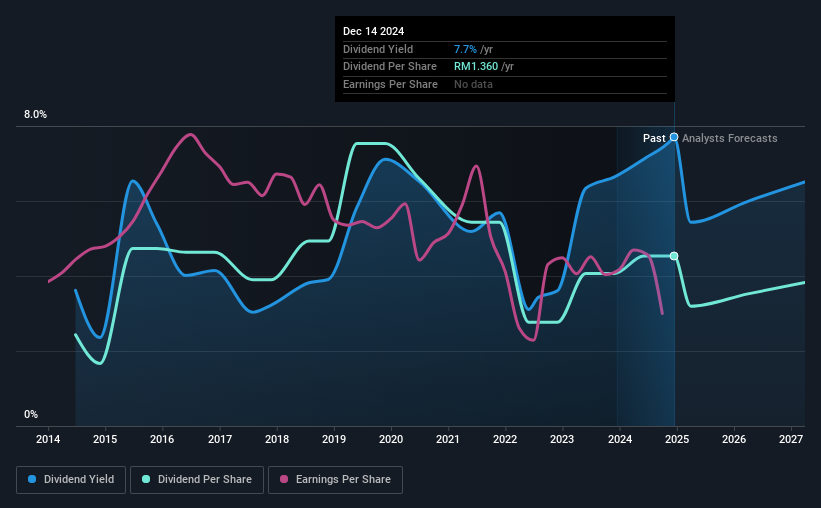- Malaysia
- /
- Consumer Durables
- /
- KLSE:PANAMY
Don't Race Out To Buy Panasonic Manufacturing Malaysia Berhad (KLSE:PANAMY) Just Because It's Going Ex-Dividend

Panasonic Manufacturing Malaysia Berhad (KLSE:PANAMY) stock is about to trade ex-dividend in three days. The ex-dividend date is one business day before the record date, which is the cut-off date for shareholders to be present on the company's books to be eligible for a dividend payment. The ex-dividend date is important because any transaction on a stock needs to have been settled before the record date in order to be eligible for a dividend. Meaning, you will need to purchase Panasonic Manufacturing Malaysia Berhad's shares before the 19th of December to receive the dividend, which will be paid on the 20th of January.
The company's next dividend payment will be RM00.15 per share, on the back of last year when the company paid a total of RM1.36 to shareholders. Based on the last year's worth of payments, Panasonic Manufacturing Malaysia Berhad stock has a trailing yield of around 7.7% on the current share price of RM017.64. If you buy this business for its dividend, you should have an idea of whether Panasonic Manufacturing Malaysia Berhad's dividend is reliable and sustainable. We need to see whether the dividend is covered by earnings and if it's growing.
View our latest analysis for Panasonic Manufacturing Malaysia Berhad
If a company pays out more in dividends than it earned, then the dividend might become unsustainable - hardly an ideal situation. Panasonic Manufacturing Malaysia Berhad paid out 139% of profit in the past year, which we think is typically not sustainable unless there are mitigating characteristics such as unusually strong cash flow or a large cash balance. Yet cash flows are even more important than profits for assessing a dividend, so we need to see if the company generated enough cash to pay its distribution. Over the past year it paid out 136% of its free cash flow as dividends, which is uncomfortably high. We're curious about why the company paid out more cash than it generated last year, since this can be one of the early signs that a dividend may be unsustainable.
Panasonic Manufacturing Malaysia Berhad does have a large net cash position on the balance sheet, which could fund large dividends for a time, if the company so chose. Still, smart investors know that it is better to assess dividends relative to the cash and profit generated by the business. Paying dividends out of cash on the balance sheet is not long-term sustainable.
Cash is slightly more important than profit from a dividend perspective, but given Panasonic Manufacturing Malaysia Berhad's payments were not well covered by either earnings or cash flow, we are concerned about the sustainability of this dividend.

Have Earnings And Dividends Been Growing?
Companies with falling earnings are riskier for dividend shareholders. If earnings fall far enough, the company could be forced to cut its dividend. Panasonic Manufacturing Malaysia Berhad's earnings per share have fallen at approximately 11% a year over the previous five years. Such a sharp decline casts doubt on the future sustainability of the dividend.
Another key way to measure a company's dividend prospects is by measuring its historical rate of dividend growth. In the past 10 years, Panasonic Manufacturing Malaysia Berhad has increased its dividend at approximately 6.4% a year on average. The only way to pay higher dividends when earnings are shrinking is either to pay out a larger percentage of profits, spend cash from the balance sheet, or borrow the money. Panasonic Manufacturing Malaysia Berhad is already paying out a high percentage of its income, so without earnings growth, we're doubtful of whether this dividend will grow much in the future.
The Bottom Line
Has Panasonic Manufacturing Malaysia Berhad got what it takes to maintain its dividend payments? It's looking like an unattractive opportunity, with its earnings per share declining, while, paying out an uncomfortably high percentage of both its profits (139%) and cash flow as dividends. This is a clearly suboptimal combination that usually suggests the dividend is at risk of being cut. If not now, then perhaps in the future. With the way things are shaping up from a dividend perspective, we'd be inclined to steer clear of Panasonic Manufacturing Malaysia Berhad.
So if you're still interested in Panasonic Manufacturing Malaysia Berhad despite it's poor dividend qualities, you should be well informed on some of the risks facing this stock. Every company has risks, and we've spotted 1 warning sign for Panasonic Manufacturing Malaysia Berhad you should know about.
A common investing mistake is buying the first interesting stock you see. Here you can find a full list of high-yield dividend stocks.
New: Manage All Your Stock Portfolios in One Place
We've created the ultimate portfolio companion for stock investors, and it's free.
• Connect an unlimited number of Portfolios and see your total in one currency
• Be alerted to new Warning Signs or Risks via email or mobile
• Track the Fair Value of your stocks
Have feedback on this article? Concerned about the content? Get in touch with us directly. Alternatively, email editorial-team (at) simplywallst.com.
This article by Simply Wall St is general in nature. We provide commentary based on historical data and analyst forecasts only using an unbiased methodology and our articles are not intended to be financial advice. It does not constitute a recommendation to buy or sell any stock, and does not take account of your objectives, or your financial situation. We aim to bring you long-term focused analysis driven by fundamental data. Note that our analysis may not factor in the latest price-sensitive company announcements or qualitative material. Simply Wall St has no position in any stocks mentioned.
About KLSE:PANAMY
Panasonic Manufacturing Malaysia Berhad
Manufactures and sells electrical home appliances and related components under the Panasonic brand name in Malaysia, Japan, rest of Asia, Europe, the Middle East, and internationally.
Flawless balance sheet with moderate growth potential.
Market Insights
Community Narratives



